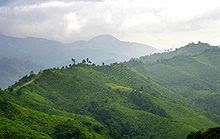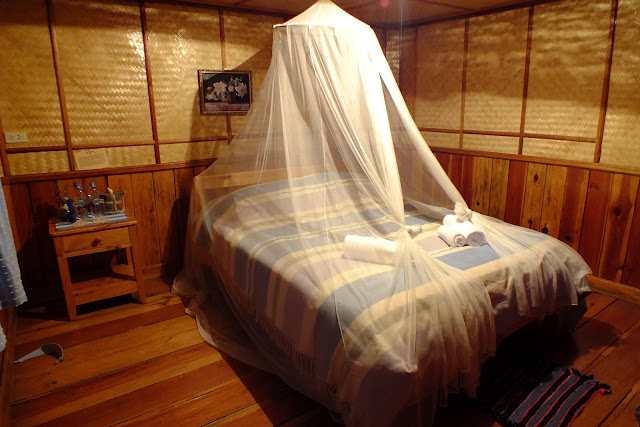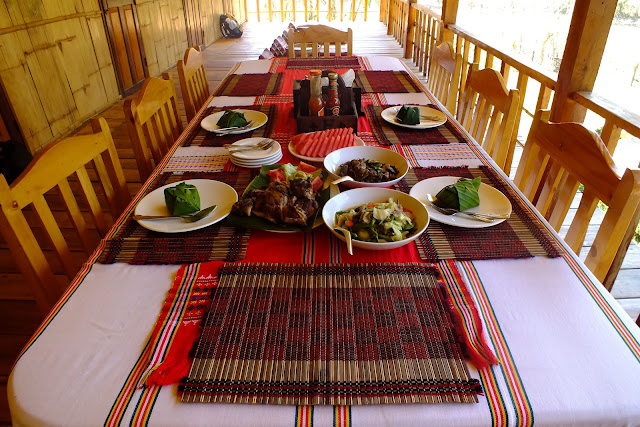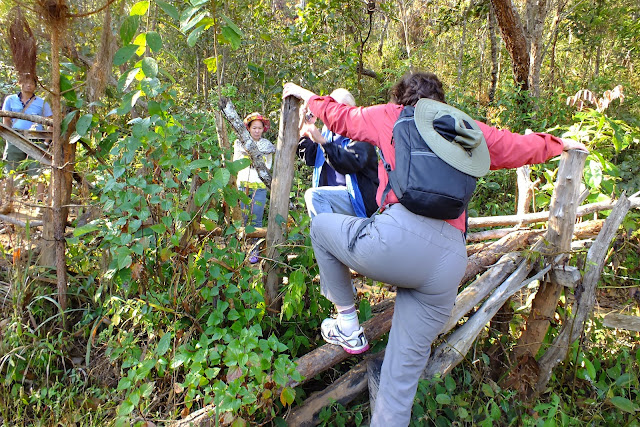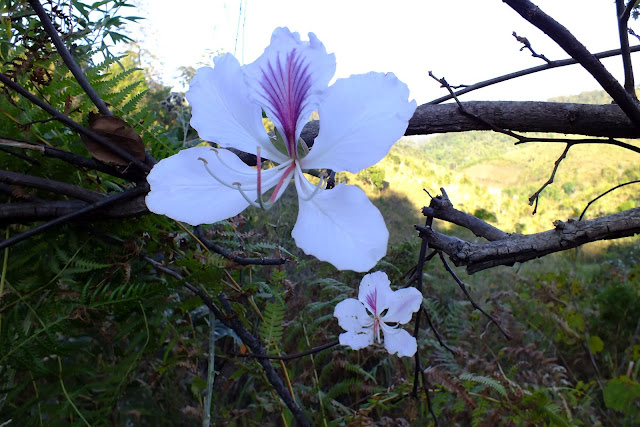Thailand's Geologic Diversity
The remarkable diversity of Thailand's natural resources provokes curiosity and begs a myriad of questions regarding the influence of this diversity on the micro-cultures and life-style of Thailand's inhabitants.
 |
| Mountains of the North |
Dramatic Contrasts
Three principle geographic regions comprise Thailand.
These can be further sub-divided into at least four distinct marine sub-regions, three mountainous regions and the Chao Phraya drainage system which is vast, complex and diverse in its own right.
The three principle regions are the northern mountains, the vast, nearly-flat central flood plain and delta of the Chou Phraya River, and, the peninsular mountains, lowland hills, limestone karsts and magnificent seashores of the Malay Peninsula.
 |
| Delta slough of the Chao Phraya River |
Thailand's seashore(s) is actually two separate entities, the Andaman Sea of the Malay Peninsula's West Coast, and the magnificent crescent of beaches rimming the Gulf of Siam, (now known as the Gulf of Thailand).
Both, the Andaman Sea and the Gulf of Thailand, host several archipelagos comprised of beautiful islands and reefs abundantly populated with fish and spectacular invertebrate marine life.
| National Park - koh Lanta yai |
Phuket, in the same fashion as Pattaya, has (unfortunately) been reduced to a disgusting amalgamation of rowdy, party-going tourists and Thai businessmen preying on the alchohol, drug and sex-seeking hoardes of tourists from (primarily) Eastern Europe and Australia. Several low-fare charter airlines provide a never-ending stream of gullible tourists from Russia and other European population centers during the high-season.
In defense of legitimate Thai businesses (and they are many) most of the tawdry venues are actually controlled by non-Thai ex-patriots from eastern Europe, most notably, Russia. These "businessmen" find loop-holes in the Thai statutes limiting ownership to Thai, form a partnership with a Thai man or marry a Thai woman, then manipulate the association to control the business operation.
Apparently little effort has been forthcoming by the Thai authorities to discourage illegal manipulation of the commercial code.
In contrast, are the more southern islands of Krabi Province, who have wisely discouraged the "fast-crowd" and encouraged a more family-oriented and laid-back environment. The influence of conservative Muslim and Buddhist enclaves, and the importance of agriculture, in addition to the tourism, have thus far prevented over-exploitation of the beautiful environs South of Phuket, at least for the time being.
One example of the "family-friendly" environs on koh Lanta yai, is the presence of two very fine Swedish schools which cater to the large population of semi-resident Swedish families who flock to southern Ktabi Province each northern European winter
The Island Life - Southern Thailand's koh Lanta yai
Do not plan a vacation or an extended visit to koh Lanta yai if:
- You do not like the sunshine;
- Friendly people and serene surroundings bore you;
- A wide variety of Thai food is not your cuisine of choice;
- You find calm surf, fine sand beaches and laid-back beach bars objectionable;
- A choice of many beaches, restaurants and activities will confuse and disorient you.
Traveling from Bangkok To koh Lanta yai
The best way (by far) to travel from Bangkok to koh Lanta yai is to book a flight on AsiaAir from Suvarnabhumi Airport in Bangkok to the Krabi International Airport. The actual flight is approximately 1.5 hours to the airport in Krabi Province. The Krabi airport is safe, modern and very user friendly.
As of October 15th 2012, AsiaAir will change its location in Bangkok (for all domestic flights) to Don Muang Airport. Another option for travelers from northern and eastern Europe, and from North America, is to consider a flight to Kuala Lumpur, Malaysia. AsiaAir and Thai Air provide direct flights to Krabi from Kuala Lumpur if you do not have an interest in visiting Bangkok.
 | |
| Passenger Ferry Boat - Ao nang to Outer Island Resorts |
- By passenger only ferry boat from Ao nang, a near-by village pier;
- Private air-conditioned van (most expensive) but the most timely option;
- Community bus to Krabi Town then transfer to a shared air-conditioned van (recommended).
Before you depart Bangkok for Krabi and koh Lanta is important to understand and follow this routine if you choose my recommended travel option from the airport to koh Lanta yai:
- Contact Black Tiger Tours and request you speak to "peng". He is the owner, speaks English and will do everything humanly possible to make sure you have a successful journey from Krabi airport to your accommodations on koh Lanta yai. peng can be reached here. His phone number is 089-7297126 or 075-612499.
- Provide peng your flight arrival information and he will, in turn, advise you regarding your van reservation to koh Lanta yai.
- When you arrive at the Krabi airport, opposite the baggage claim area, you will see a pair of small booths with a sign that says "TAXI" of "LIMO". As you approach the booth, you will be accosted by several ambitious, smiley and friendly Thai girls who will want to sell you a limo ticket. Smile back at them and say, "need ticket on bus to Krabi pier." They will sell you a bus ticket and guide you to your bus, which will take you directly to peng at the Black Tiger rendezvous (great food at peng's place while you wait for your van...if there is a wait, which is rare).
The Black Tiger air conditioned van will take you from Krabi Town, via two ferry crossings and about a 1.5 - 2 hour ride, directly to your lodging on the island. At the time of this post, the cost per person is 300 THB (about 9 USD) as opposed to 1800 THB per person if you opt for the limo at the airport...a significant difference!
Your return from koh Lanta to Krabi will be arranged and booked by your lodging host. The van will pick you up at your lodging and take you directly to the Krabi airport...no transfers required.
Choosing this option will result in a saving approximately 3000 THB per person in RT travel costs, enough to probably pay for your entire bar bill or pay for a full day, two-person snorkel trip (complete with lunch) to an outer island!
LODGING - Where To Stay
The link provided here
will take you to a website that has an interactive map of koh Lanta
yai. You can place your mouse cursor on the segments of the map, left-click and it will
expand the segment, providing the location of each major beach and the
resorts located on each beach.
I suggest you use a booking service such as Agoda and also Trip Advisor
to explore the possibilities of individual resorts noted on the map.
Also, bear-in-mind that a number of new or remodeled resorts and restaurants open up at the
beginning of each season.
Before the beginning of the
"high-season" for 2012 (15 November 2012 - 15 March 2013) I will add a
short blog post to note the newest resorts and restaurants I've had a
chance to personally visit on koh Lanta before the 2012 season gets into
"high-gear."
 | |
| And the beach is only 150 meters away! |
 |
| View from the deck of an "Old Town" Pole House |
Your choices are about as varied as you can imagine. I have stayed in modest cabanas, rented a modern apartment for a long-stay (three months) and have had friends reside in everything from Five-Star accommodation to funky, rehabilitated pole houses perched above the the calm waters of "Old Town".
I think it depends on the level of service you demand, your willingness to seek alternative variations of the island-beach-living experience and (of course) your self-imposed budget constraints.
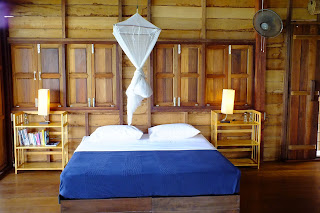 |
| Pole House comfort - Mango House, Old Town Lanta |
I have found that one way to really enjoy this island, is to book a stay at one of the many conveniently located, modestly priced resorts near Saladan (Klong Dao) or Long Beach (Phra Ae), then explore the island by motor bike.
If you find a resort at the South end of the island, which is much quieter and laid back, then you can easily make the transition from the more "up-tempo" area of Long Beach and the beach at Klong Dao (near the village of Saladan) to your new find.
Favorite Beaches - koh Lanta yai
The West facing (Andaman Sea) coastline has the only beaches worthy of mention. There are many, some quite obvious and easy to find; others not so obvious and requiring a sense of adventure. The latter are the most pristine and beautiful. It is so much fun to load a backpack, take off in the early morning, and seek a remote and isolated mini-beach and just "hang" for the better part of a day.
The last section of this post provides photos from my stay in 2012, of some beaches I enjoyed. The vast majority of these beaches are easily accessed by renting a motor bike and heading South towards the National Park.
If you wish to enter the National Park (and I heartily recommend a visit to the beautiful beach there) a small entrance fee is required for non-Thai visitors. It is well worth the very modest outlay!
Beach Klong Dao
There are too many beaches to mention here, so I'll briefly describe a few of the more accessible beaches and great places to eat or enjoy a liquid refreshment near-by. The busiest, but one of the most beautiful beaches (especially for kids), is Klong Dao, near the village of Saladan.
| Veed View Pub - Beach front dining and relaxation |
Not only is it a great walking beach with plenty of resorts, but it's centrally located. My favorite place to eat at this beach is Veed View, a beautifully constructed pub and restaurant right on the beach. (Beautiful sunsets are an added bonus).
Veed View is a terrific place for snacks, lunch, dinner or cold drinks. There is a nightly beach BBQ and the staff is just terrific, hospitable and they welcome families with kids of all ages.
Beach Phra Ae
Phra Ae is known by the "farang" as Long Beach, and, is just that...long! You can spend an entire day walking from one end of Phra Ae to the opposite end, then catch a ride back to your starting point in one of the many three-wheeled "tuk tuks" that constantly patrol the highway, looking for passengers.
There are many beach restaurants and refreshment stops along the way.
| Marina Resort - Thatched-roof Bungalows |
At the southern-most end of Phrae Ae, is a funky little resort known as Marina Resort. The small thatched roof bungalows are in a garden-like setting on the beach and very modestly priced. The Marina has a very fine cook and serves a broad and varied menu of Thai dishes as-well-as a "farang" breakfast.
Marina makes a convenient departure point for hikes either direction...to the North, the entire length of Phrae Ae, or to the South, around a rocky promontory to three separate, lovely beaches.
| Soontreeya Lobby Sala |
| Soontreeya Bungalows |
It is a quiet venue with terrific hosts, toon and puy, who arrange your return transportation and excursions about koh Lanta .
There are several snorkeling sites off-shore to which they will arrange a ride for you, elephant treks and many other activities revealing the several beaches and island venues of interest.
Anda Lanta Resort - Klong Jaak Bay
 |
| Coffee or fruit snacks on the beach |
I hosted two friends from North America for a month in
Thailand, ten days of which they stayed on koh Lanta. Trisha and Karen
spent the first two days at Marina Resort at the South end of Phra Ae
Beach.
The third day, they moved to the very quiet and beautiful confines of
Anda Lanta Resort, near the National Park, at Klong Jaack Bay. I think
the photos below, speak much more adequately than my narrative, about
the hospitality and natural beauty of koh Lanta's southern beach venues!
 |
| Massage anyone |
It is probably pointless for me to tell you how much Trish and Karen
enjoyed their time at the South end of the island. The beaches are
pristine and uncrowded.
Access to adjacent beaches is easily
accomplished by motor-bike, song thaew or, if you are very motivated and
ambitious, by kyak or simply hiking!
 | ||
| Looking to the right - mid-day and contemplating lunch! |
 |
| Looking to the left -sunrise and morning coffee! |
 | ||
| Alternative boat styles for transportation to outer-island beaches |
There are many modes of transportation for getting about while you are on the island of koh Lanta.
Some are more practical; some are more fun!
 |
| Song Thaew (song tao) |
 | |||
| Friendly Pachyderm |
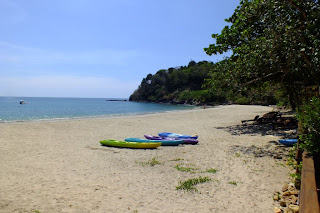 | ||
| Exercise and visit the beach around the corner! |
Photo Essay of koh Lanta Beaches - 2011 thru 2012
| Snorkel site - Four Island Day Trip |
| Primary Beach - National Park |
| Beach at "Same Same But Different" - Restaurant South of Klong Nin |
| Bamboo (Pai) Beach - South of Klong Nin |
 |
| This beach is actually one of two, a short distance North of the National Park |
Personal Reflections
| The ubiquitous motor-bike. |
I have now visited koh Lanta on three separate occasions. The first trip was basically a "reconnoiter" of the island to make an assessment of its potential for a long-stay.
The first trip I met and was befriended by a local Thai family with whom I have become very attached. Their hospitality and encouragement led me to a three-month extended stay during the 2012 high season.
During my stay, I explored many varied venues on the island and came to know several other Thai families, with whom I have enjoyed countless hours of exposure to their island life-style and hospitality.
Following are some comments off the top of my head, that summarize my observations after living on koh Lanta for over three months:
- A stay of less than 10 days to 2 weeks severely limits your exposure to the many opportunities available for exploring and enjoying the great variety of beaches, local restaurants and activities.
- Families are probably most comfortable in a setting that provides detached accommodations (bungalows) but a variety of activities to keep the kids happy, e.g. a swimming pool in addition to the beach, access to conveniences (shops and the local 7/11), a variety of eating establishments.
- Adults unaccompanied by children would probably enjoy the seclusion of the southern beaches and the great cuisine of the local restaurants within easy access of their resort.
Two restaurant favorites for fantastic food and ambiance are Khao Yai (at the top of the mountain between Klong Nin and Lanta Old Town) and on the beach at Kantiang Bay, the restaurant Same Same But Different ( a short drive South from Klong Nin).
- The beaches remote from your resort are best enjoyed if you are well prepared, i.e., take bottled water, plenty of sunscreen and Aloe gel for sunburn treatment.
- Prepare a back-pack with towels and a small first-aid kit (disinfectant and band aids) and a snack. Half-day trips are really the best approach if you don't pack a lunch.
- You will find the ocean water to be very warm (86 F, 30 C), free of current and with gentle surf. Some beaches have rocky bottoms and drop off from the shallows rather quickly, so if you have kids, be sure to monitor them closely.
- The ocean is typically clear, so underwater obstacles and terrain (the bottom substrate) can be easily observed. Snorkels, fins and masks (or swim goggles) are very handy as is a hat!
You will occasionally encounter micro-organisms in seawater that irritate the skin. They are a nuisance but harmless and can be flushed away with fresh water or a mild solution of vinegar and water.
 | |
| Giant Tropical Clam (carefully re-placed precisely where found unattached to the substrate) |
Avoid touching or handling dead or alive sea creatures, such as jelly-fish, crabs or the cone-shaped seashells. The seashells actually have a "stinger" (probiscus) containing an extremely poisonous toxin that can be injected into your flesh.
| Crabby Critter will inflict pain if you try to touch him! |
| koh Ha Beach - Snorkel and Picnic (Day Trip by Lanta Garden Hill Speedboats) |
A trip to koh Lanta yai is truly a retreat into a vanishing paradise. Like so many of the once remote, pristine wildernesses, whether arctic, temperate or tropical; be they alpine, desert or marine in character, these magnificent venues seem not able to escape the explosive growth of international tourism.
The "third-world's" obsession to mimic the economy of "developed" nations and Asia's exponential population growth and total disregard for environmental stewardship is slowly eroding these ecosystems' ability to sustain the variety, quantity and quality of life unique to their individual and disparate habitats.
A trip now, to koh Lanta yai, may be your last chance to see!
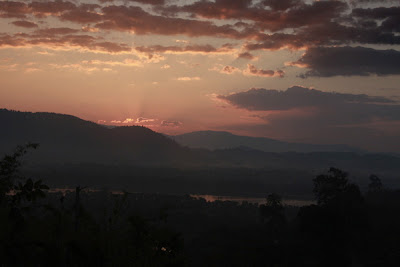 | ||
| Sunrise |
 |
| Sunset |




